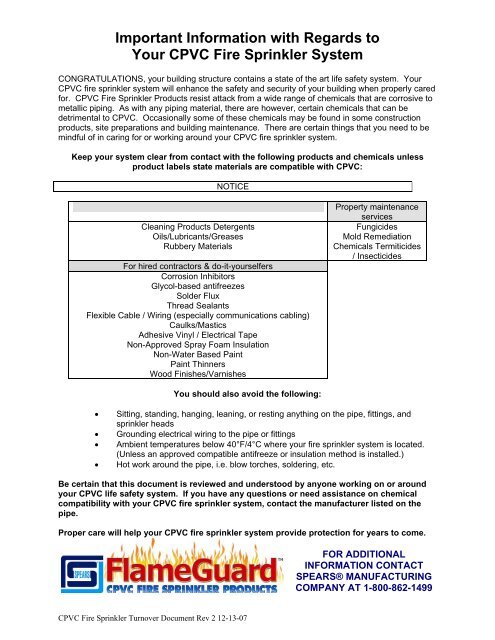Fire Protection Design Manual - Office of Construction and Facilities ...
Fire Protection Design Manual - Office of Construction and Facilities ...
Fire Protection Design Manual - Office of Construction and Facilities ...
Create successful ePaper yourself
Turn your PDF publications into a flip-book with our unique Google optimized e-Paper software.
Important Information with Regards to<br />
Your CPVC <strong>Fire</strong> Sprinkler System<br />
CONGRATULATIONS, your building structure contains a state <strong>of</strong> the art life safety system. Your<br />
CPVC fire sprinkler system will enhance the safety <strong>and</strong> security <strong>of</strong> your building when properly cared<br />
for. CPVC <strong>Fire</strong> Sprinkler Products resist attack from a wide range <strong>of</strong> chemicals that are corrosive to<br />
metallic piping. As with any piping material, there are however, certain chemicals that can be<br />
detrimental to CPVC. Occasionally some <strong>of</strong> these chemicals may be found in some construction<br />
products, site preparations <strong>and</strong> building maintenance. There are certain things that you need to be<br />
mindful <strong>of</strong> in caring for or working around your CPVC fire sprinkler system.<br />
Keep your system clear from contact with the following products <strong>and</strong> chemicals unless<br />
product labels state materials are compatible with CPVC:<br />
NOTICE<br />
Ordinary considerations<br />
Cleaning Products Detergents<br />
Oils/Lubricants/Greases<br />
Rubbery Materials<br />
For hired contractors & do-it-yourselfers<br />
Corrosion Inhibitors<br />
Glycol-based antifreezes<br />
Solder Flux<br />
Thread Sealants<br />
Flexible Cable / Wiring (especially communications cabling)<br />
Caulks/Mastics<br />
Adhesive Vinyl / Electrical Tape<br />
Non-Approved Spray Foam Insulation<br />
Non-Water Based Paint<br />
Paint Thinners<br />
Wood Finishes/Varnishes<br />
You should also avoid the following:<br />
Property maintenance<br />
services<br />
Fungicides<br />
Mold Remediation<br />
Chemicals Termiticides<br />
/ Insecticides<br />
• Sitting, st<strong>and</strong>ing, hanging, leaning, or resting anything on the pipe, fittings, <strong>and</strong><br />
sprinkler heads<br />
• Grounding electrical wiring to the pipe or fittings<br />
• Ambient temperatures below 40°F/4°C where your fire sprinkler system is located.<br />
(Unless an approved compatible antifreeze or insulation method is installed.)<br />
• Hot work around the pipe, i.e. blow torches, soldering, etc.<br />
Be certain that this document is reviewed <strong>and</strong> understood by anyone working on or around<br />
your CPVC life safety system. If you have any questions or need assistance on chemical<br />
compatibility with your CPVC fire sprinkler system, contact the manufacturer listed on the<br />
pipe.<br />
Proper care will help your CPVC fire sprinkler system provide protection for years to come.<br />
CPVC <strong>Fire</strong> Sprinkler Turnover Document Rev 2 12-13-07<br />
FOR ADDITIONAL<br />
INFORMATION CONTACT<br />
SPEARS® MANUFACTURING<br />
COMPANY AT 1-800-862-1499

















